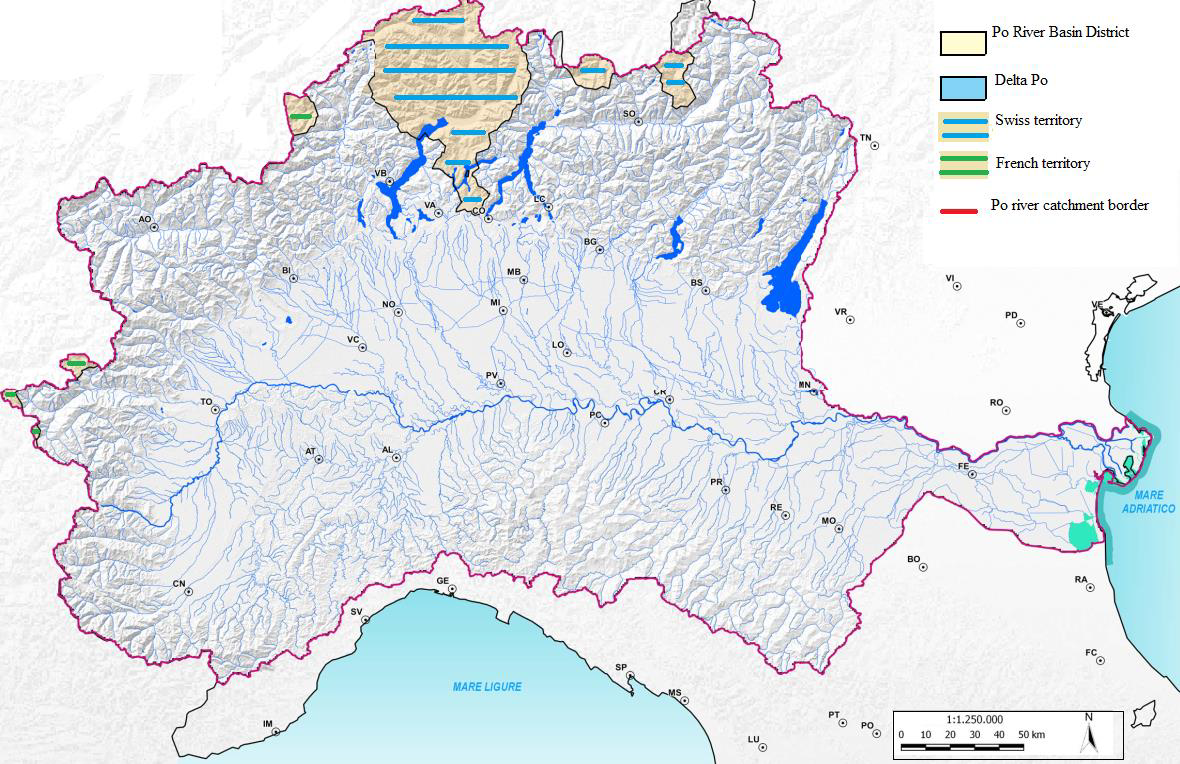PA 3.1 – Po river basin
The Po River Basin has an area of 74.000 km2 and among those about 71.000 km2 are in Italy, and for a small part in Swiss (Toce catchment) and marginally in France. With about 16 million inhabitants, territory represents an exceptionally socio-economical, landscape and geographical varied reality.
| Objective(s) of pilot actions / Aim of testing in the territorial level | We consider hydrological modelling, stakeholders engagement and Climate/Land Use Change (CC and LUC) effects assessment the basic pillars for drinking water management and protection; also delivering a strong, positive feedback towards the integration of water resources, land use and environmental management. For this reason the objectives of our PA are: • improvement of hydrological information and modelling for floods and droughts, also accounting for CC and LUC • identifying the main gaps of Integrated Water Resources Management (IWRM) and the BMP addressing them at our PA scale • considering potential synergies and crucial conflicts among stakeholders on water demand and land use • analyzing and supplying hints to improve the Permanent Observatory on Water Uses and the Flood Forecast Center • disseminating activities and results in order to increase water resources knowledge and awareness Within the aim of our testing there is the proposal of instruments, tools, processes and opportunities for strengthening stakeholders involvement, discussion, sharing of problems and solutions as also for arising potential synergies. Finally, our PA testing will be an opportunity to improve, to share with Project partners and to extend our local/regional/national experiences of inter-sectoral planning and multilevel governance, with a special focus on ecosystem services. |
| Expected achievable results | • improved data bases, information layers and modelling systems • support to improve methodologies and procedures of early warning systems • increase stakeholders amount and their involvement • climate change analysis and impact on floods and droughts for both planning and management applications • expanded knowledge of the Po river basin useful to improve actual and future practices and measures for drinking water protection |
| Timeframe of implementation of achievable actions | • improved data bases, information layers and modelling systems: concluded • support to improve methodologies and procedures of early warning systems: in progress • increase the engagement of stakeholders and their interest: in progress, to be completed within June 2019 • increase the awareness about the effects of CC and LUC on hydrological hazards and drinking water resources for planning and strategic purposes: in progress, to be completed within the end of the project • expanded knowledge of the Po river basin useful to improve actual and future practices and measures for drinking water protection: concluded Periodical actions: • periodical meeting of the Permanent Observatory on Water Uses • event related activities of the Flood Forecast Center Within the end of the project we wish to do further steps in collaboration and exchange of information with HERA, the Multiservice –Drinking water supply Manager selected among the main stakeholders. |
| Expected benefits for national/regional stakeholders | The model represents a showcase scenario for similar catchments in Bavaria. Moreover, the final model constitutes an implementation example for modelling activities in other catchments. National/regional stakeholders are: • institutions involved in environmental protection, land use/water management ( including Land reclamation and irrigation Boards) and emergency management • water authorities and Company Associations • private sector ( agriculture, industry, energy, farming, internal shipping, tourism etc.) • researchers (Universities, thematic Institutes, Foundations) They have opportunities to: • link to decision support systems • share experiences and solutions • discuss needs, problems and proposals • start collaboration among them • increase awareness on drought, floods and CC impact on drinking water • test the usefulness of integrated water resources management for protecting water quality and quantity • consider the value of natural resources and recognize the related ecosystem services These benefits could be fulfilled through: • active participation, meeting, workshops and collaboration • research and operational improvement of FEWS/DEWS (Flood/Drought Early Warning Systems ) • political effort for giving more power to agreement tools • progressively turn IWRM to circular economy, including principles, tools and procedures of greening policies. |
| Expected benefits for local stakeholders | Local stakeholders are: • local institutions involved in environmental protections, land use and water management • local researches • municipalities and urban areas governments and management • citizens associations/NGO • water supply managers including drinking water managers • private sector (agriculture, industry, energy, farming, tourism etc.) They have opportunities to: • link to decision support systems • implement a top- down approach from upper governance levels (national and regional) • share experiences and solutions • discuss needs, problems and proposals • start collaboration among them • increase awareness on drought, floods and CC impact on drinking water • test the usefulness of integrated water resources management for protecting water quality and quantity • consider the value of site specific natural resources and identifying ecosystem services focusing on the more representative environmental problems These benefits could be fulfilled through: • active participation, meeting, workshops and collaboration • research and operational improvement of FEWS/DEWS (flood/drought early Warning Systems ) • political effort for giving more power to agreement tools • further implementation of green public procurement and of minimum environmental criteria for urban services (water, transport, wastes etc.) . |

Reports:
Deliverables T2.1.2 can be found here: Transnational report about best management practices and annex 8: Best management practices in PA 3.1.
Deliverable T2.1.4 can be found here: Descriptive documentation about PA 3.1.
Deliverable T2.1.5 can be found here: Set-up report about adaptation of the transnational concept to PA 3.1.
Deliverable T2.2.2 can be found here: Partner-specific pilot action documentation.
Deliverable T2.3.1 can be found here: Evaluation report for each pilot action.
